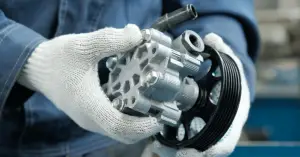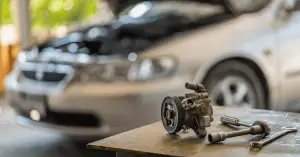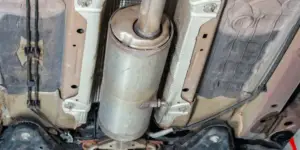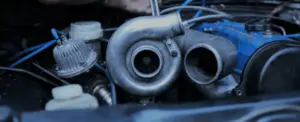
Power steering is an essential part of operating an automobile safely and securely. Without it, the car becomes difficult to control. You may find yourself having to rev the engine more than normal just to get the car to function properly. So, what is the reason the power steering only works at high RPM?
One of the main reasons the power steering system only works at high RPM is a malfunctioning power steering pump. This could be caused by trapped air inside the pump, damaged pump vanes, or leaky hoses. The best way to fix this is to replace the power steering pump immediately.
In this article, we will examine why a vehicle’s power steering might only work at high revolutions-per-minute (RPM) of the engine. Not only will we cover all the possible causes of this issue, but we will go into a few good solutions for each. You may want to call a mechanic, but you can actually fix most of these issues on your own! Let’s begin.
What Causes the Power Steering Pump to Fail?

If you’ve noticed that the wheel of your vehicle is terribly heavy and difficult to steer unless your engine is revving at a high RPM, you’re definitely dealing with a power steering malfunction.
Before we can dive into this issue, let’s talk about how power steering works when it is functioning as it should. This will provide insight into the different components that could add up to a problem with the power steering, especially if it is only working while the engine has a high rate of RPMs.
A power steering pump pressurizes using power steering fluid, which is directed by a series of hoses, valves, and cylinders. With this hydraulic power, the direction of your steering wheel is transferred to the rack box and the actual wheels of the car. However, when this process changes drastically, your power steering pump might only be able to do its job at high RPMS.
1. Air is Trapped in the Power Steering Pump
You’ll know if air is causing the issue in the power steering pump if you hear a lot of noise. When the wheel is hard to steer and the pump groans loudly, you’ve got air stuck inside and the pump can break down entirely.
To fix this, you can either completely replace the power steering pump, or you can try to “bleed” the system. This is a process that is different depending on the manufacturing of the power steering pump and the model of vehicle you own, so check the manual for instructions. One way is to put the front end up on jack stands, open up the throttle while the engine is at idle, then steer from the left to the right in rapid succession.
2. Damaged Pump Vanes and Cylinders
Another source of loud noises that indicate you have a problem with your power steering pump is damaged vanes. This is caused by vibration of the power steering pump and overheating. This is all causing the vanes of the power steering pump to rub up against the slots they sit in, which wears them down very quickly.
Without the vanes, the pump cannot apply pressure to the rack box like it should, so your steering becomes heavy and a loud noise accompanies it. You can try to solve this problem by replacing the vanes, but since the slots for the vanes are likely worn down too, the best solution is to replace the whole pump.
The same goes for damaged pump cylinders, which also affects the pump’s pressure in power steering.
3. Leaking Hoses
Another consequence of natural wear and tear on the power steering pump is the breakdown of the valves and hoses. These conduct power steering fluid. Once they start to leak, your pump cannot operate effectively, with no pressurization abilities and a nasty mess.
Again, you can try to fix this issue using replacement hoses and restored seals, and this is sometimes more effective than replacing hardware like cylinders and valves. However, as previously mentioned, you should replace the whole power steering pump.
How to Replace the Power Steering Pump

Now that we know the driving issue behind the power steering, let’s cover how to replace the power steering pump.
If you’ve never done this before, odds are, the operation might seem anything but simple. Luckily, we’ve prepared a step-by-step guide to replacing a power steering pump.
1. Collect Tools and Materials
The best laid plans are ones with the right equipment! Here’s what you’ll need:
- Power steering pump replacement
- Power steering fluid, at least two quarts
- AT fluid for flushing and filling
- Power steering pulley puller
- Socket set
- Leverage pipe
- Grease, made specifically for wheel bearings
- A level
- Set of wrenches
- Drain pan, for flushing the system
2. Properly Drain the Power Steering
To drain the power steering section, open the bleed valve just a crack. You’ll need to then turn the steering wheel at least five times, then close the valve and add steering fluid. This is called “flushing” the system. You’ll have to repeat this process until the fluid can move without trapped air.
3. Take Out Power Steering Accessories
Some of the power steering accessories you will probably need to get out of the way are the negative battery cable (make sure all power to the vehicle is off before attempting this, and wear gloves for safety,) and the power steering belt.
Next, take off the power steering return hoses and pressure hoses. Some power steering pumps have fluid level sensors that also need to be removed, but not all.
4. Take Out Bolts, Pulley, and Power Steering Pump
Next up is the pulley, which is one of the more complex parts to rid yourself of. Use the power steering pulley puller you got from Step 1 to take the pulley out. Before you can remove the power steering pump, you’ll also need to take out the wrenches and disconnect the bolts attached to it. Then, simply lift out the power steering pump from it’s brackets.
5. Secure the New Power Steering Pump
Settle the new power steering pump firmly into the bracket the same way the old one sat inside. Re-attach the bolts. Attach the pressure hose back onto the pump, but do not attach the return pump until after you’ve flushed the machine oil and grease.
6. Use Pulley Press to Attach Power Steering Pulley
Screw the hub press of the power steering pulley onto the through bolt. Then grease both the pump hub and the pulley itself. Next, you can put the pulley on the pump hub, then tighten the bolt as far as it will go on the hub itself.
When the pulley is aligned with the equipment that’s belted, you can remove the hub press and the through bolt.
7. Attach Bolts by Aligning the Pulley
Now that you’ve attached the pulley, align it carefully to the other assembly pieces of your vehicle. The power steering pulley needs to line up perfectly with the crankshaft pulley. Your level will come in handy with these, and you’ll know you’ve done it right because it will not make noise when you start the car.
Attach both the serpentine belt and the AC belt.
8. Flush Again & Fill the System
Finally, you just need to repeat the flushing process using ATF instead of power steering fluid. When you finish, attach the return hose back to the pump and fill it up for a final time.
Frequently Asked Questions
Why does my car go through power steering fluid so fast?
If you find yourself with an empty power steering pump every few days, it’s usually because of a leak. When this occurs, the steering wheel may become heavy and difficult to operate.
Power steering pumps, as mentioned above, begin leaking as a natural effect of time and use. The wear and tear of driving causes the pump’s seals to weaken and the rings constructing the pump to lose their shape and durability. Naturally, you’ll start to experience leaks in the car and a need to constantly replenish your power steering fluid!
One of the easiest ways to resolve this issue cleanly is to simply replace the whole power steering pump.
Why does my power steering pump whine at low RPM?
If your engine is revving low and it produces a loud whine, it’s probably due to your power steering fluid. When the power steering fluid levels are low, it will produce straining noises from the pump itself.
To solve this, refill the fluid right away. If the fluid becomes contaminated, or if it is no longer viscous, drain it completely and refill it. Otherwise it will create that whining noise, too.
In Conclusion
If your power steering only works at high RPM, causes are almost exclusively related to the power steering pump itself. If the vehicle has leaks in any of it’s hoses, pressure cannot be applied by the pump correctly. Additionally, if air gets into the pump or the vanes and cylinders become damaged, it will also become ineffective.
The best way to solve any of these issues is to replace the whole pump in it’s entirety. First, you need to collect all the materials. Then, drain the steering fluid and remove the power steering pump, starting with the accessories. Afterward, make sure to attach the pulley properly before you flush and re-fill the system.
When you replace the power steering pump, it should work no matter how high the RPMs of the engine are!





![Should You Rev Match When Downshifting? [The Truth] Shutterstock_1068955487-1](https://carzaza.com/wp-content/uploads/2023/12/Shutterstock_1068955487-1-300x157.png)







